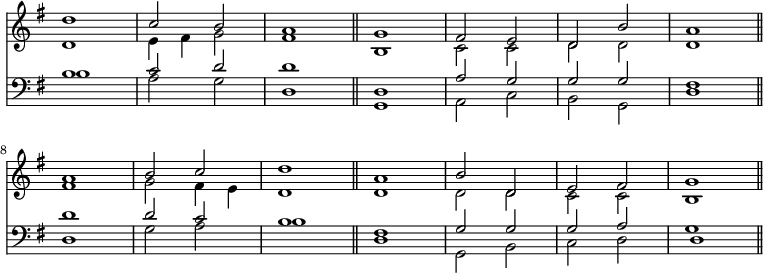gradually arose as to the essential character of church music; double chants, and pretty melodies with modern major or minor harmonies, came to be substituted for the single strains, the solemn and manly recitation tones, and the grand harmonies of the 16th century. The Georgian period teemed with flighty chants, single and double; many of which can hardly be called either reverential or beautiful—terms which no one can apply to the following (by Camidge [App. p.584 "Crotch"],) still in frequent use, and by no means the worst that might be quoted:—

But however objectionable this practice may be regarded, it must be confessed that many very charming melodies have been produced on the lines of the modern double chant by modern composers of great eminence. The following by Dr. Crotch is remarkable for its grace and elegance, as well as for the severity of the contrapuntal rule to which the quondam Oxford professor has subjected himself in its construction (per recte et retro). Each of the four parts in the former half of the chant has its notes repeated backwards in the corresponding bars of the second half.

It remains to add a few remarks on the arrangement of the words in chanting.
That the principles of the old Latin chanting were adopted in setting the music to the new English liturgy and offices, is evident from every text-book of English chanting from Archbishop Cranmer's letter to Henry VIII and from Marbeck downwards, as long as any decent knowledge of the subject remained in English choirs. Little by little, however, the old rules were entirely neglected; generally speaking, neither the clergy nor the lay members of the English choirs knew anything more about chanting than the oral traditions of their own churches; thus things grew gradually worse and worse, till no rule or guide seemed left; choirmen and boys took their own course, and no consent nor unity of effect remained, so far as the recitation and division of the words were concerned.
On the revival of Church principles in 1830–1840 our own English documents of ecclesiastical chanting, and the pre-Reformation sources from which they were derived, began to be studied. Pickering and Rimbault each re-edited Marbeck. Dyce and Burns published an adaptation of his plainsong to the Prayer Book. Oakley and Redhead brought out the 'Laudes diurnæ' at the chapel in Margaret Street, London. Heathcote published the Oxford Psalter, 1845. Helmore's 'Psalter Noted' (1849–50) took up Marbeck's work, at the direction after the Venite—'and so with the Psalms as they be appointed'—and furnished an exact guide for chanting according to the editor's view of the requirements of the case. Moreton Shaw, Sargent, and J. B. Gray also published Gregorian Psalters.
Meantime the modern Anglican chant was being similarly cared for. Numerous books, beginning with that of Mr. Janes (1843), issued from the press, giving their editors' arrangement of the syllables and chant notes for the Psalter and Canticles. Among the most prominent of these may be mentioned Mr. Hullah's 'Psalms with Chants' (1844); Helmore's 'Psalter Noted' (1850); the Psalter of the S.P.C.K. edited by Turle (1865); the 'English Psalter' (1865); the 'Psalter Accented' (1872); the 'Cathedral Psalter' (1875); the Psalters of Ouseley, Elvey, Gauntlett, Mercer, Doran and Nottingham, Heywood and Sargent. Among these various publications there reigned an entire discrepancy as to the mode of distributing the words. Beyond the division of the verse into two parts given in the Psalms and Canticles of the Prayer Book, no pointing or arrangement of the words to the notes of the chant has ever been put forward by authority in the Anglican Church, or even widely accepted. Each of the editors mentioned has therefore followed his own judgment, and the methods employed vary from the strictest syllabic arrangement to the freest attempt to make the musical accent and expression agree with those which would be given in reading—which is certainly the point to aim at in all arrangements of words for chanting, as far as consistent with fitness and common sense. It may be hoped that the increased attention given to this important subject, may lead to the use of those guide books only which best reconcile the demands of good reading and good singing.
[ T. H. ]
CHANTERELLE, a French term for the upper or E string of the violin—that on which the melody is usually sung.
[ G. ]
CHAPEAU CHINOIS. [Chinese Pavilion.]
CHAPELLE, originally the musicians of a chapel, and now extended to mean the choir or the orchestra, or both, of a church or chapel or other musical establishment, sacred or secular. The maître de chapelle is the director of the music. In German the word Kapelle or Capelle is used more exclusively for the private orchestra

